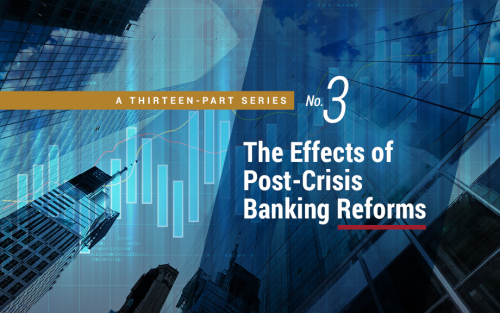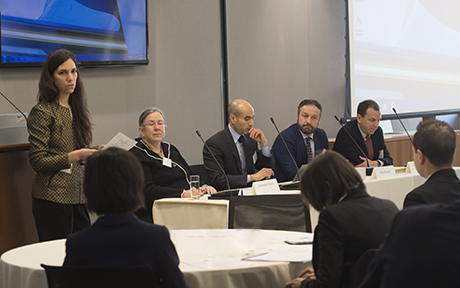How Large Are Default Spillovers in the U.S. Financial System?

When a financial firm suffers sufficiently high losses, it might default on its counterparties, who may in turn become unable to pay their own creditors, and so on. This “domino” or “cascade” effect can quickly propagate through the financial system, creating undesirable spillovers and unnecessary defaults. In this post, we use the framework that we discussed in “Assessing Contagion Risk in a Financial Network,” the first part of this two-part series, to answer the question: How vulnerable is the U.S. financial system to default spillovers?
Assessing Contagion Risk in a Financial Network

Duarte, Jones, and Ruela describe how stress can propagate through the financial system and sketch out an approach for quantifying economic losses stemming from default cascades.
Understanding Cyber Risk: Lessons from a Recent Fed Workshop

Cyber risk poses a major threat to financial stability, yet financial institutions still lack consensus on the definition and terminology around cyber risk, and lack a common framework for confronting these hazards. This impedes efforts to measure and manage such risk, diminishing institutions’ individual and collective readiness to handle system-level cyber threats. In this blog post, we describe the proceedings of a recent workshop, where leading risk managers, academics, and policy makers gathered to discuss proposals for countering cyber risk. This workshop is part of a joint two-phase initiative between the Federal Reserve Banks of Richmond and New York and the Fed’s Board of Governors to harmonize cyber risk identification, classification, and measurement practices.
Resolving “Too Big to Fail”

Many market participants believe that large financial institutions enjoy an implicit guarantee that the government will step in to rescue them from potential failure. These “Too Big to Fail” (TBTF) issues became particularly salient during the 2008 crisis. From the government’s perspective, rescuing these financial institutions can be important to avoid harm to the financial system. The bailouts also artificially lower the risk borne by investors and the financing costs of big banks. The Dodd-Frank Act attempts to remove the incentive for governments to bail out banks in the first place by mandating that each large bank file a “living will” that details its strategy for a rapid and orderly resolution in the event of material distress or failure without disrupting the broader economy. In our recent New York Fed staff report, we look at whether living wills are effective at reducing the cost of implicit TBTF bailout subsidies.
Tax Reform’s Impact on Bank and Corporate Cyclicality

The Tax Cuts and Jobs Act (TCJA) is expected to increase after-tax profits for most companies, primarily by lowering the top corporate statutory tax rate from 35 percent to 21 percent. At the same time, the TCJA provides less favorable treatment of net operating losses and limits the deductibility of net interest expense. We explain how the latter set of changes may heighten bank and corporate borrower cyclicality by making bank capital and default risk for highly levered corporations more sensitive to economic downturns.
Good News, Leverage, and Sudden Stops

One of the major debates in open economy macroeconomics is the extent to which capital inflows are beneficial for growth. In principle, these flows allow countries to increase their consumption and investment spending beyond their income by enabling them to tap into foreign saving. Periods of such borrowing, however, are associated with large trade deficits, external debt accumulation, and, in some cases, overheating when these economies operate beyond their potential output level for an extended period of time. The relevant question in this context is whether the rate at which a country is taking on external debt has useful predictive information about financial crises.
Did the Dodd‑Frank Act End ‘Too Big to Fail’?

One goal of the Dodd-Frank Act of 2010 was to end “too big to fail.” Toward that goal, the Act required systemically important financial institutions to submit detailed plans for an orderly resolution (“living wills”) and authorized the FDIC to create an alternative resolution procedure. In response, the FDIC has developed a “single point of entry” (SPOE) strategy, under which healthy parent companies bear the losses of their failing subsidiaries. Since SPOE makes the parent company responsible for subsidiaries’ losses, we would expect parents to become riskier, relative to their subsidiaries, compared to before the announcement of the SPOE strategy in December 2013. Do bond raters and investors share this view?
Does More “Skin in the Game” Mitigate Bank Risk‑Taking?

It is widely said that a lack of “skin in the game” would distort lenders’ incentives and cause a moral hazard problem, that is, excessive risk-taking. If so, does more skin in the game—in the form of extended liability—reduce bankers’ risk-taking? In order to examine this question, we investigate historical data prior to the Great Depression, when bank owners’ liability for losses in the event of bank failure differed by state and primary regulator. This post describes our preliminary findings.
New Report Assesses Structural Changes in Global Banking

The Committee on the Global Financial System, made up of senior officials from central banks around the world and chaired by New York Fed President William Dudley, recently released a report on “Structural Changes in Banking after the Crisis.” The report includes findings from a wide-ranging study documenting the significant structural adjustments in banking systems around the world in response to regulatory, technological, and market changes after the crisis, while also assessing their implications for financial stability, credit provision, and capital markets activity. It includes a new banking database spanning over twenty-one countries from 2000 to 2016 that could serve as a valuable reference for further analysis. Overall, the study concludes that the changed regulatory and market environment since the crisis has led banks to alter their business models and balance sheets in ways that make them more resilient but also less profitable, while continuing their role as intermediaries providing financial services to the real economy.











 RSS Feed
RSS Feed Follow Liberty Street Economics
Follow Liberty Street Economics